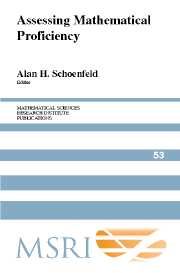Book contents
- Frontmatter
- Contents
- Preface
- Acknowledgments
- Section 1 The Big Picture
- Section 2 Perspectives on Mathematical Proficiency
- Section 3 What Does Assessment Assess? Issues and Examples
- Section 4 The Case of Algebra
- Section 5 What Do Assessments Assess? The Case of Fractions
- Section 6 The Importance of Societal Context
- Epilogue What Do We Need to Know? Items for a Research Agenda
- About the Authors
- Subject Index
- Author Index
- Task Index
Section 3 - What Does Assessment Assess? Issues and Examples
Published online by Cambridge University Press: 06 July 2010
- Frontmatter
- Contents
- Preface
- Acknowledgments
- Section 1 The Big Picture
- Section 2 Perspectives on Mathematical Proficiency
- Section 3 What Does Assessment Assess? Issues and Examples
- Section 4 The Case of Algebra
- Section 5 What Do Assessments Assess? The Case of Fractions
- Section 6 The Importance of Societal Context
- Epilogue What Do We Need to Know? Items for a Research Agenda
- About the Authors
- Subject Index
- Author Index
- Task Index
Summary
It is said that a picture is worth a thousand words. When it comes to assessment, an example is worth that and more. Someone may claim to assess student understanding of X, but what does that mean? The meaning becomes clear when one sees what is actually being tested. Examples help for many reasons. They make authors’ intentions clear, and they teach. In working through good examples of assessments, one learns how to think about student understanding. This section of the book offers a wide range of examples and much to think about.
In Chapter 6, Hugh Burkhardt takes readers on a tour of the assessment space. He asks a series of questions related to the creation and adoption of assessments, among them the following: Who is a particular assessment intended to inform? What purpose will it serve? (To monitor progress? To guide instruction? To aid or justify selection? To provide system accountability?) Which aspects of mathematical proficiency are valued? How often should assessment take place to achieve the desired goals? What will the consequences of assessment be, for students, teachers, schools, parents, politicians? What will it cost, and is the necessary amount an appropriate use of resources? Burkhardt lays out a set of design principles, and illustrates these principles with a broad range of challenging tasks. The tasks, in turn, represent the mathematical values Burkhardt considers central: specifically, that the processes of mathematizing and mathematical modeling are centrally important, as is the need for students to explain themselves clearly using mathematical language.
In Chapter 7, Jan de Lange continues the tour of mathematical assessments. Like Burkhardt, he believes that assessment development is an art form, and that like any art form, it follows certain principles, in the service of particular goals. He introduces the framework for the development of the Program for International Student Assessment. PISA assessments, like those of TIMSS (which formerly stood for Third International Mathematics and Science Study, and now for Trends in International. . . ), are international assessments of mathematical competence. PISA differs substantially from TIMSS in that it focuses much more on students’ ability to use mathematics in applied contexts. Hence, a design characteristic of PISA problems is that they must be realistic: the mathematics in the problems must correspond, in a meaningful way, to the phenomena they characterize. De Lange also argues that valuable assessments should highlight not only what students can do, but what they find difficult, sometimes pinpointing significant (and remediable) omissions in curricula.
Information
- Type
- Chapter
- Information
- Assessing Mathematical Proficiency , pp. 75 - 76Publisher: Cambridge University PressPrint publication year: 2007
